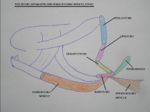Difference between revisions of "Hyoid Apparatus - Anatomy & Physiology"
Jump to navigation
Jump to search
Fiorecastro (talk | contribs) |
m (Text replace - "Oral Cavity - Tongue - Anatomy & Physiology" to "Tongue - Anatomy & Physiology") |
||
| (8 intermediate revisions by 4 users not shown) | |||
| Line 1: | Line 1: | ||
| − | {{ | + | {{toplink |
| + | |backcolour =CDE472 | ||
| + | |linkpage =Musculoskeletal System - Anatomy & Physiology | ||
| + | |linktext =Musculoskeletal System | ||
| + | |maplink = Musculoskeletal System (Content Map) - Anatomy & Physiology | ||
| + | }} | ||
| + | <br> | ||
==Introduction== | ==Introduction== | ||
| − | The hyoid apparatus holds the [[Larynx - Anatomy & Physiology|larynx]] in place and supports the [[Pharynx - Anatomy & Physiology|pharynx]] and [[Tongue - Anatomy & Physiology|tongue]] from the skull. | + | The hyoid apparatus holds the [[Larynx - Anatomy & Physiology|larynx]] in place and supports the [[Pharynx - Anatomy & Physiology|pharynx]] and [[Tongue - Anatomy & Physiology|tongue]] from the skull. |
| − | |||
| + | It is made up of 5 different bones which vary in length and size depending on the species. | ||
| + | [[Image:Hyoid Anatomy.jpg|thumb|right|150px|Hyoid Apparatus in situ - Copyright Nottingham]] | ||
==Structure and Function== | ==Structure and Function== | ||
| − | + | *Attached to the temporal region of the skull by a [[Joints - Anatomy & Physiology#Cartilaginous Joints|synchondrosis]] | |
| − | + | *Palpable through [[Pharynx - Anatomy & Physiology|pharynx]] | |
| − | [[ | + | *Visible when the [[Pharynx - Anatomy & Physiology|pharynx]] is viewed through the mouth |
| − | + | *Basihyoid is palpable within the intermandibular space | |
| − | + | *Sternohyoid muscle pulls hyoid caudally | |
| − | + | *Geniohyoid muscle pulls hyoid rostrally | |
| + | [[Image:Hyoid Bones.jpg|thumb|right|150px|Hyoid Apparatus Drawing - Copyright nabrown]] | ||
| + | ===The hyoid bones=== | ||
| − | + | *Basihyoid | |
| + | **Lingual process present in some species which protrudes into the roof of the [[Tongue - Anatomy & Physiology|tongue]] | ||
| + | **Unpaired | ||
| − | + | *Stylohyoid | |
| + | **Articulates with base of skull at petrus temporal | ||
| + | **Paired | ||
| − | + | *Epihyoid | |
| + | **Paired | ||
| − | + | *Keratohyoid | |
| + | **Paired | ||
| − | [[ | + | *Thyrohyoid |
| + | **Articulates with [[Larynx - Anatomy & Physiology#Thyroid Cartilage|thyroid cartilage]] of [[Larynx - Anatomy & Physiology|larynx]] | ||
| + | **Paired | ||
| + | ==Species Differences== | ||
| + | [[Image:Canine Hyoid.jpg|thumb|right|150px|Canine hyoid apparatus - Copyright Nottingham]] | ||
===Carnivores=== | ===Carnivores=== | ||
| + | *Stylohyoid bones not palpable | ||
| − | + | ===Equine=== | |
| + | *Epihyoid small | ||
| − | + | *Lingual process present | |
| − | + | *Well developed stylohyoid muscle | |
===Ruminants=== | ===Ruminants=== | ||
| − | + | *Lingual process present | |
| − | Lingual process | ||
===Porcine=== | ===Porcine=== | ||
| + | *Lingual process present | ||
| − | + | ==Test yourself with the Hyoid Apparatus Flashcards== | |
| − | + | [[Hyoid Apparatus - Musculoskeletal - Flashcards|Hyoid Apparatus Flashcards]] | |
| − | |||
| − | |||
| − | |||
| − | + | [[Category:Musculoskeletal System]] | |
| − | |||
| − | [[Category:Musculoskeletal System | ||
| − | |||
Revision as of 17:07, 4 September 2010
|
|
Introduction
The hyoid apparatus holds the larynx in place and supports the pharynx and tongue from the skull.
It is made up of 5 different bones which vary in length and size depending on the species.
Structure and Function
- Attached to the temporal region of the skull by a synchondrosis
- Palpable through pharynx
- Visible when the pharynx is viewed through the mouth
- Basihyoid is palpable within the intermandibular space
- Sternohyoid muscle pulls hyoid caudally
- Geniohyoid muscle pulls hyoid rostrally
The hyoid bones
- Basihyoid
- Lingual process present in some species which protrudes into the roof of the tongue
- Unpaired
- Stylohyoid
- Articulates with base of skull at petrus temporal
- Paired
- Epihyoid
- Paired
- Keratohyoid
- Paired
- Thyrohyoid
- Articulates with thyroid cartilage of larynx
- Paired
Species Differences
Carnivores
- Stylohyoid bones not palpable
Equine
- Epihyoid small
- Lingual process present
- Well developed stylohyoid muscle
Ruminants
- Lingual process present
Porcine
- Lingual process present


